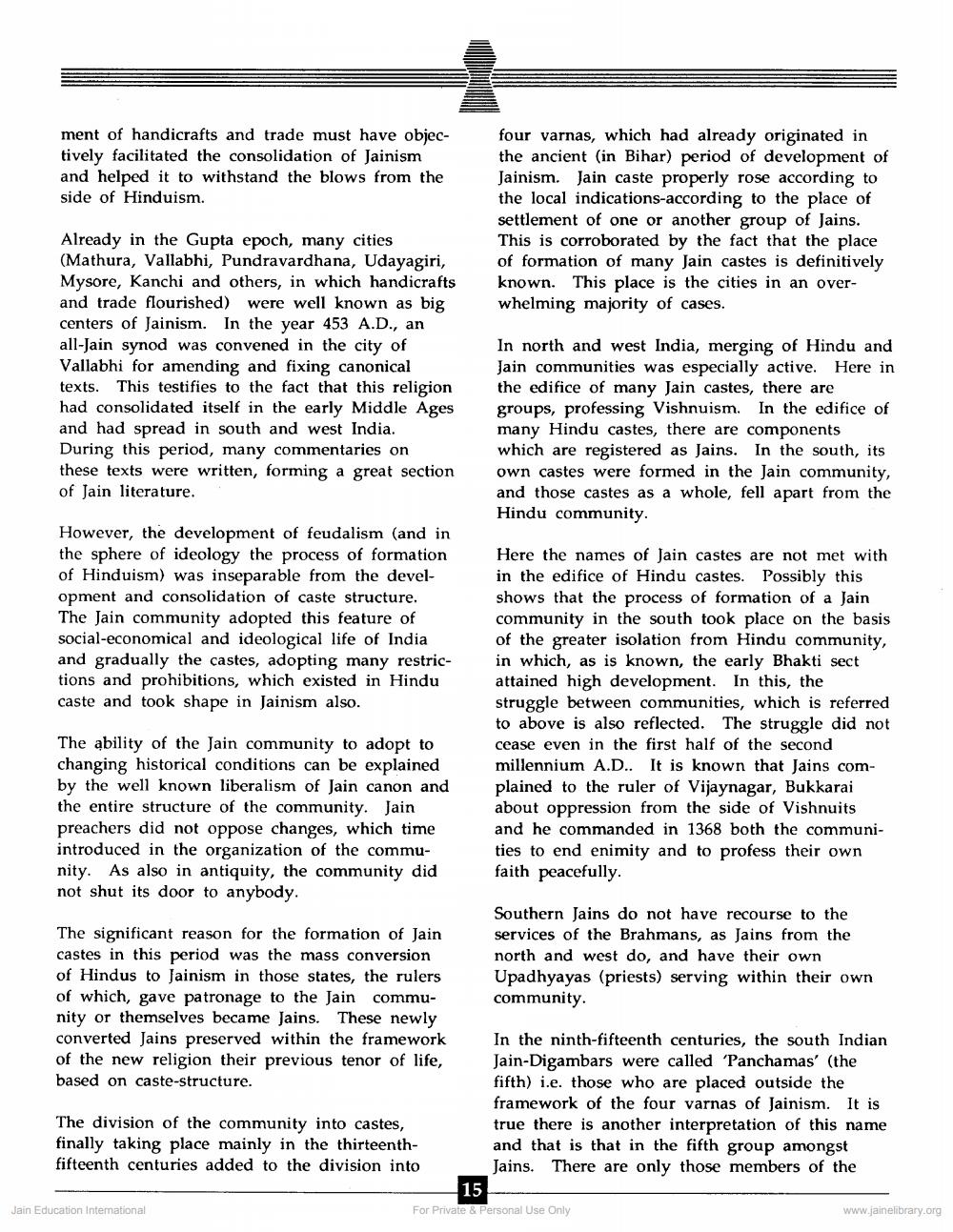________________
ment of handicrafts and trade must have objectively facilitated the consolidation of Jainism and helped it to withstand the blows from the side of Hinduism.
Already in the Gupta epoch, many cities (Mathura, Vallabhi, Pundravardhana, Udayagiri, Mysore, Kanchi and others, in which handicrafts and trade flourished) were well known as big centers of Jainism. In the year 453 A.D., an all-Jain synod was convened in the city of Vallabhi for amending and fixing canonical texts. This testifies to the fact that this religion had consolidated itself in the early Middle Ages and had spread in south and west India. During this period, many commentaries on these texts were written, forming a great section of Jain literature.
However, the development of feudalism (and in the sphere of ideology the process of formation of Hinduism) was inseparable from the development and consolidation of caste structure. The Jain community adopted this feature of social-economical and ideological life of India and gradually the castes, adopting many restrictions and prohibitions, which existed in Hindu caste and took shape in Jainism also.
The ability of the Jain community to adopt to changing historical conditions can be explained by the well known liberalism of Jain canon and the entire structure of the community. Jain preachers did not oppose changes, which time introduced in the organization of the community. As also in antiquity, the community did not shut its door to anybody.
The significant reason for the formation of Jain castes in this period was the mass conversion of Hindus to Jainism in those states, the rulers of which, gave patronage to the Jain community or themselves became Jains. These newly converted Jains preserved within the framework of the new religion their previous tenor of life, based on caste-structure.
The division of the community into castes, finally taking place mainly in the thirteenthfifteenth centuries added to the division into
Jain Education Intemational
four varnas, which had already originated in the ancient (in Bihar) period of development of Jainism. Jain caste properly rose according to the local indications-according to the place of settlement of one or another group of Jains. This is corroborated by the fact that the place of formation of many Jain castes is definitively known. This place is the cities in an overwhelming majority of cases.
In north and west India, merging of Hindu and Jain communities was especially active. Here in the edifice of many Jain castes, there are groups, professing Vishnuism. In the edifice of many Hindu castes, there are components which are registered as Jains. In the south, its own castes were formed in the Jain community, and those castes as a whole, fell apart from the Hindu community.
Here the names of Jain castes are not met with in the edifice of Hindu castes. Possibly this shows that the process of formation of a Jain community in the south took place on the basis of the greater isolation from Hindu community, in which, as is known, the early Bhakti sect attained high development. In this, the struggle between communities, which is referred to above is also reflected. The struggle did not cease even in the first half of the second millennium A.D.. It is known that Jains complained to the ruler of Vijaynagar, Bukkarai about oppression from the side of Vishnuits and he commanded in 1368 both the communities to end enimity and to profess their own faith peacefully.
Southern Jains do not have recourse to the services of the Brahmans, as Jains from the north and west do, and have their own Upadhyayas (priests) serving within their own community.
In the ninth-fifteenth centuries, the south Indian Jain-Digambars were called 'Panchamas' (the fifth) i.e. those who are placed outside the framework of the four varnas of Jainism. It is true there is another interpretation of this name and that is that in the fifth group amongst Jains. There are only those members of the
15
For Private & Personal Use Only
www.jainelibrary.org




